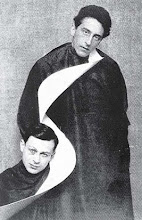Daniele da Volterra, Portrait of Michelangelo, Chalk, 1533, Teylers Museum, Haarlem, The Netherlands
After his
recovery, Michelangelo returned to work, and finished the Last Judgment in a
few months. It was exposed to the
public on Christmas Day in 1541.
Michelangelo, The Last Judgment (detail), 1537-41, Sistine Chapel, The Vatican, Rome.
Michelangelo, The Last Judgment (detail), 1537-41, Sistine Chapel, The Vatican, Rome.
Time, negligence,
and outrage, the dust of centuries, the burned papers of successive conclaves,
the smoke of altar-candles, the hammers and the hangings of upholsterers, the
brush of the breeches-maker and restorer, have so dealt with the Last Judgment
that it is almost impossible to do it justice now. What Michelangelo intended by his scheme of
colour is entirely lost. Not only did
Daniele da Volterra, an execrable colourist, dab vividly tinted patches upon
the modulated harmonies of flesh-tones painted by the master; but the whole surface has sunk into a bluish
fog, deepening to something like lamp-black around the altar. Nevertheless, in
its composition the fresco may still be studied; and after due inspection, aided by
photographic reproductions of each portion, we are not able to understand the
enthusiasm which so nobly and profoundly planned a work of art aroused among contemporaries.
John Addington Symonds, Photographic portrait dedicated to Walt Whitman, 1889.
It has sometimes
been asserted that this painting, the largest and most comprehensive in the
world, is a tempest of contending forms, a hurly-burly of floating, falling,
soaring, and descending figures. Nothing
can be more opposed to the truth.
Michelangelo was sixty-six years of age when he laid his brush down at
the end of the gigantic task. He had
long outlived the spontaneity of youthful ardour. His experience through half a century in the
planning of monuments, the painting of the Sistine vault, the designing of
facades and sacristies and libraries, had developed the architectonic sense
which was always powerful in his conceptive faculty. Consequently, we are not surprised to find
that , intricate and confused as the scheme may appear to an unpractised eye,
it is in reality a design of mathematical severity, divided into four bands or
planes of grouping.
Notes:
1. John Addington Symonds' superb, moving and highly enjoyable The Life of Michelangelo (1893) should be sought out by anyone interested in the artist. A short biography of Symonds, advocate and champion of l'amour de l'impossible, is found Here.
2. Restoration and cleaning of The Last Judgment was completed in 1994. A short New York Times article concerning the unveiling is found Here.
Michelangelo, The Last Judgment, 1537-41, Sistine Chapel, The Vatican, Rome.
Notes:
1. John Addington Symonds' superb, moving and highly enjoyable The Life of Michelangelo (1893) should be sought out by anyone interested in the artist. A short biography of Symonds, advocate and champion of l'amour de l'impossible, is found Here.
2. Restoration and cleaning of The Last Judgment was completed in 1994. A short New York Times article concerning the unveiling is found Here.











